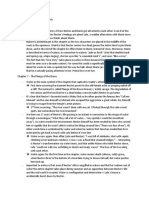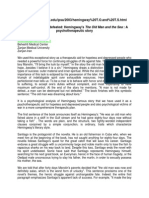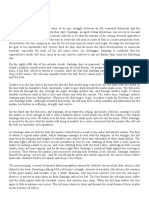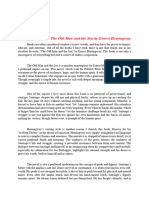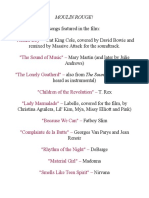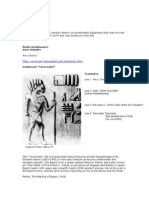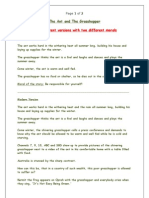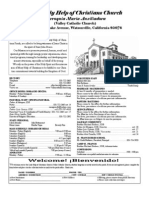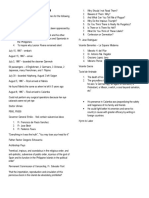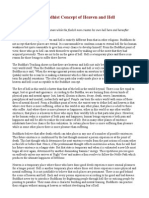0 ratings0% found this document useful (0 votes)
146 viewsThe Old Man and The Sea: Santiago's Struggle in
The Old Man and The Sea: Santiago's Struggle in
Uploaded by
AdoptedchildThe document provides an in-depth analysis of the protagonist Santiago in Hemingway's novel "The Old Man and the Sea". It summarizes that Santiago is an old Cuban fisherman who has gone 84 days without catching a fish. He is described as humble yet proud. When he catches a giant marlin, he must battle sharks to bring the fish home, displaying his stubborn will and pride. The document analyzes Santiago as a representative of humanity's struggle for survival against the challenges of nature.
Copyright:
© All Rights Reserved
Available Formats
Download as DOCX, PDF, TXT or read online from Scribd
The Old Man and The Sea: Santiago's Struggle in
The Old Man and The Sea: Santiago's Struggle in
Uploaded by
Adoptedchild0 ratings0% found this document useful (0 votes)
146 views9 pagesThe document provides an in-depth analysis of the protagonist Santiago in Hemingway's novel "The Old Man and the Sea". It summarizes that Santiago is an old Cuban fisherman who has gone 84 days without catching a fish. He is described as humble yet proud. When he catches a giant marlin, he must battle sharks to bring the fish home, displaying his stubborn will and pride. The document analyzes Santiago as a representative of humanity's struggle for survival against the challenges of nature.
Original Description:
Practica Santiago
Original Title
Practica Santiago
Copyright
© © All Rights Reserved
Available Formats
DOCX, PDF, TXT or read online from Scribd
Share this document
Did you find this document useful?
Is this content inappropriate?
The document provides an in-depth analysis of the protagonist Santiago in Hemingway's novel "The Old Man and the Sea". It summarizes that Santiago is an old Cuban fisherman who has gone 84 days without catching a fish. He is described as humble yet proud. When he catches a giant marlin, he must battle sharks to bring the fish home, displaying his stubborn will and pride. The document analyzes Santiago as a representative of humanity's struggle for survival against the challenges of nature.
Copyright:
© All Rights Reserved
Available Formats
Download as DOCX, PDF, TXT or read online from Scribd
Download as docx, pdf, or txt
0 ratings0% found this document useful (0 votes)
146 views9 pagesThe Old Man and The Sea: Santiago's Struggle in
The Old Man and The Sea: Santiago's Struggle in
Uploaded by
AdoptedchildThe document provides an in-depth analysis of the protagonist Santiago in Hemingway's novel "The Old Man and the Sea". It summarizes that Santiago is an old Cuban fisherman who has gone 84 days without catching a fish. He is described as humble yet proud. When he catches a giant marlin, he must battle sharks to bring the fish home, displaying his stubborn will and pride. The document analyzes Santiago as a representative of humanity's struggle for survival against the challenges of nature.
Copyright:
© All Rights Reserved
Available Formats
Download as DOCX, PDF, TXT or read online from Scribd
Download as docx, pdf, or txt
You are on page 1of 9
Santiagos Struggle in
The Old Man and the Sea
In order to properly analyze Hemingways perspective on the individuals status in the
face of God, nature, society and Universe, one has to understand how he began his writings and
what influenced him in his success of implying a feeling of wonder in the readers. The sense of
awe that it created in its author, its publisher, and (to judge by many of the reviewers) its readers
(35) is what is interesting about Hemingway as E.M. Halliday states. This feeling can be induced
to readers via the use of symbolical and biblical elements and images. The fact that the author
opts for using ordinary characters to put them in extraordinary situations to confront themselves
with unusual events, brings to light their qualities, qualities that are similar or at the same time
representative for human nature, qualities, traits or events that resemble Santiagos experiences
in The Old Man and the Sea.
The protagonist in Hemingways The Old Man and the Sea is Santiago, an old fisherman
who lives in the village of Cojimar, a Cuban village. He spends his days fishing in the Gulf
Stream, until his lucky days come to an end and he finds himself in a misfortune of eighty four
days. The author starts presenting the main character right from the beginning of the novel and
shows to the readers a slightly well detailed image of the old man:
[he] was thin and gaunt with deep wrinkles in the back of his neck. The brown
blotches of the benevolent skin cancer the sun brings from its reflection on the
tropic sea were on his cheeks. The blotches ran well down the sides of his face
and his hands had the deep-creased scars from handling heavy fish on the cords.
But none of these scars were fresh. They were old as erosions in a fishless desert.
(Hemingway, The Old Man and the Sea 9-10)
What is interesting and, at the same time, wonderful and outstanding is the way
Hemingway succeeds in presenting a characters entire life in just a few lines, showing the
readers that Santiagos life is one full of humility and endurance, while the scars and the marks
of the sun rays are proof for this.
Hemingway continues to describe his character and tells the readers that everything
about him was old except his eyes and they were the same color as the sea and where cheerful
and undefeated (Hemingway, The Old Man and the Sea 10). The author creates a parallel
between Santiagos eyes color and the sea itself, trying to say that beneath the stillness of
Santiagos eyes and beneath the cheerfulness there is actually something more. The cheerfulness
and the undefeated status of his eyes could lead the readers in assuming that even if he is an old
fisherman with clear signs of endurance he is far from giving back, he is like his eyes, an
undefeated human being with an undying hope. There are few people who actually succeed in
achieving their goals after being oppressed by others. Many would go by oppressing the others as
well or just give up on their dreams, but Santiago is far from this thought.
The color of his eyes may also be a hint to his origins. In the novel he is constantly
oppressed by the other fishermen while he is being made fun of as well. In the essay Eyes The
Same Color as The Sea1, Jeffrey Herlihy says that Santiago might be a Spaniard born in the
Canary Islands, near the coast of Africa (25). This idea is justified when the protagonist dreams
of lions on the coasts of Africa.
The protagonist is a humble and simple person, a characteristic that differentiates him from the
other fishermen:
[Santiago] he was too simple to wonder when he had attained humility. But he
knew he had attained it and he knew it was not disgraceful and it carried no loss
of true pride. (Hemingway, The Old Man and the Sea 14)
The idea of humility is enforced when the author talks about the old mans shack: a bed,
a table, one chair and a place on the dirt floor to cook with charcoal (Hemingway, The Old Man
and the Sea 14).
This trait is one that does not change during the novel, as Santiago is a humble person in
everything he does and encounters. He treats the sea as a being, as he does not underestimate his
opponents, nature and the great marlin. Even if he is not a religious person, he relinquishes to
some extent his pride and asks with humility for Gods help. Speaking of pride, Santiago is a
proud man, and does not give up on pride entirely not even when asking God for help, a means
through which he tries to explain that he is still a man and that through individual power he is
able to overcome any obstacles, whether they are represented by nature or by the society in
1 According to a letter that Hemingway sent to Lillian Ross
which he lives. At the same time Santiagos a stubborn person, a trait born from his pride that
during this individual struggle against nature will prepare him for whatever challenges he will
encounter: How do you feel fish? he asked. I feel good and my left hand is better and I have
food for a night and a day. Pull the boat fish (Hemingway, The Old Man and the Sea 82). Pride
is the engine that powers up Santiago, it is the force that makes him decide to venture far in the
Gulf in order to make a last stance and catch the great Marlin:
You did not kill the fish only to keep alive and to sell for food, he thought. You
killed him for pride and because you are a fisherman. You loved him when he was
alive and you loved him after. If you love him, it is not a sin to kill him. Or is it
more? (Hemingway, The Old Man and the Sea 104)
Santiago attempts to explain to himself his reasons for killing the fish, and admits that his
desire to hunt the fish stemmed from the very same quality that led to its eventual destruction:
his pride. He then justifies his acts by saying that his actions were imposed by his love and
respect to the marlin.
Santiago is a man of unclenched will who would do whatever he can in order to obtain
his prize, he would make use of his dreams and memories from youth to gain the power and
strength to continue. One crucial moment that illustrates this idea is the one when he dreams of
lions sitting on the beaches of Africa:
He no longer dreamed of storms, nor of women, nor of great occurrences, nor of
great fish, nor fights, nor contests of strength, nor of his wife. He only dreamed of
places now and of the lions on the beach. They played like young cats in the dusk
and he loved them as he loved the boy. (Hemingway, The Old Man and the Sea
24)
This is his escapism from the cruel reality that he has been enduring for some time.
Santiago forgets about his dead wife, about the storms on the sea, about being lonely and even
about the fights that he had. The image of lions playing on the beach serves as a source of
comfort and renewal for Santiago. It is like seeing puffy cats playing in front of the house, an
image suggesting a time of youth and ease. The lions are presented in strong connection to
Manolin and the reader is able to notice this towards the end of the story, when Manolin,
Santiagos only friend, is adopting a caretaker pose, watching how the old man is dreaming again
of the lions.
Another instance is when he thinks of the great baseball player DiMaggio and wonders
what he would do under such circumstances: But I must have confidence and I must be worthy
of the great DiMaggio who does all things perfectly even with the pain of the bone spur in his
heel (Hemingway, The Old Man and the Sea 67).
These were only two important instances revealing Santiagos stubbornness and pride,
but the story continues when Santiago says that pain does not matter to man (Hemingway, The
Old Man and the Sea 93) and when he is about to lose the marlin to sharks: man is not made for
defeat; he said. A man can be destroyed but not defeated (Hemingway, The Old Man and the
Sea 114). All these thoughts are representative for Santiagos main traits: humility towards his
opponents, pride, power to rise above the obstacles, stubbornness to endure everything that he
encounters.
In a battle, winning is not everything. Succeeding in not being defeated is what matters.
E.M. Halliday says we find the old Cuban fisherman in some way representative of the whole
human race in its natural struggle for survival (41).
One other important character in the novel is Manolin, Santiagos only friend and solely
helper, besides himself. Due to the fact that Manolin was Santiagos apprentice could explain
why he is so attached to our protagonist. Having in mind that everyone in the society that
Santiago lives in, mostly fishermen, make fun of him and oppress him constantly, the assumption
that Manolin could be Santiagos only connection to society may be raised.
Returning to DiMaggios image as an empowering element for Santiagos will, in the
article The Cuban Context of The Old Man and the Sea, Bickford Sylvester says that a parallel
between DiMaggio and Santiago can be established, showing that Santiago sees himself as
champion at fishing, like DiMaggio was at baseball. Even their periods of bad luck and struggle
are similar:
because DiMaggios return to form put the Yankees in a position to pull even
with their eighty-fifth win, Santiago has renewed confidence in the potential for
success of his next voyage, which happens to be his eighty-fifth. (Sylvester 247)
This fact can be the obvious proof that the New Historicist perspective can successfully
be applied to the text. Real historical events influence Santiagos life considering his beliefs and
personal behavior. DiMaggio may be considered Santiagos person in a different Universe or
corner of the world, as Santiago finds himself resembling Joe DiMaggios career struggle.
Santiago finds his inner power in DiMaggio, considering that if Joe cannot lose, neither can he:
As DiMaggios team cannot lose in its struggle, then, neither will Santiagos
team. Santiagos eighty-fifth day at sea, ending his slump with his record result,
will in reality gain something precious, if not a materially tangible trophy, for the
team he champions - the human species. (Sylvester 250)
Everyone needs somebody or something to believe in in difficult situations and everyone
looks forward to becoming someone or like someone they worship. DiMaggio is that person for
Santiagos struggle against a cruel society and powerful nature. DiMaggios career and struggle
are the catalysts for Santiagos pursuit of individuality and overcoming the obstacles that he
encounters throughout the novel.
Another important aspectabout Santiago is that through his continuous struggle against
nature, through his battle of strength and wits, he manages to perceive and understand the
surrounding world accurately:
His main interest, in representing human life through fictional forms, has
consistently been to set man against the background of his world and universe, to
examine the human situation from various points of view. (Halliday 36)
Santiago proves to have a rare determination to understand the universe when he speaks
about the beauty and the cruelty of the sea:
He was sorry for the birds, especially the small delicate dark terns that were
always flying and looking and almost never finding, and he thought, the birds
have a harder life than we do except for the robber birds and the heavy strong
ones. Why did they make birds so delicate and fine as those sea swallows when
the ocean can be so cruel? She is kind and very beautiful. But she can be so cruel
and it comes so suddenly and such birds that fly, dipping and hunting, with their
small sad voices are made too delicately for the sea. He always thought of the sea
as la mar which is what people call her in Spanish when they love her. Sometimes
those who love her say bad things of her but they are always said as though she
were a woman. (Hemingway, The Old Man and the Sea 27)
The paragraph above is creating a link with the next one as the following one is being
developed from the ideas that the afore quoted one expresses. Santiago thinks of the great sea as
of a female, who deserves the fullest respect in order for her to offer her most desireable favours
and if it is the case of the opposite, people should not judge the sea for standing up against them,
because it is not her fault, it is the moon affecting her and making her act crazily.
the old man always thought of her as feminine and as something that gave or
withheld great favours, and if she did wild or wicked things it was because she
could not help them. The moon affects her as it does a woman, he thought.
(Hemingway, The Old Man and the Sea 29)
This absolute understanding of the world that is surrounding his presence continues when
the old fisherman talks about the way the young fishermen see the sea, as a masculine entity,
considering that the younger ones see it as an enemy (Hemingway, The Old Man and the Sea
33), unlike himself who sees it as a feminine one, paying it the deserved respect and considering
it a place that can bring a lot of favors but at the same time may place a fisherman in difficult
even deadly situations wildly or wicked things (Hemingway, The Old Man and the Sea 33).
Santiagos relationship with the marlin is full of mutual respect; Santiago considers the
fish his brother and respects it but he still wants to kill him. He pays it so much respect because,
as he struggled during the entire fight to kill the fish, so did the fish in order to escape, and it did
not give up until nothing could be done. They are brothers in struggle: He is my brother. But I
must kill him and keep strong to do it (Hemingway, The Old Man and the Sea 58).
Clinton S. Burhans Jr. enforces the idea above:
He is unlike the other fish, too, in that he is a worthy antagonist for the old man,
and during his long ordeal, Santiago comes to pity the marlin and then to respect
and love him. In the end he senses that there can be no victory for either in the
equal struggle between them, that the conditions which have brought them
together have made them one. (261)
So far, Santiago becomes an emblematic figure of the human hero, due to his own vision,
that the Universe has many wonders and challenges, among which none are powerful enough to
make a man back down in his struggle against nature or in his pursuit of proving his superiority
above nature or a cruel society. Santiago considers himself a doomed man and even so, he
constantly pushes his limits until he manages to overcome any obstacles thrown at him by a
harsh destiny. Santiagos thoughts, according to which man is not made for defeata man can
be destroyed, but not defeated (Hemingway, The Old Man and the Sea 114), are crucial for
understanding his view of the world and they also embody the central message of the novel.
Santiago is the character representing the central message of the novel: when man decides to do
something and to achieve his goals, no matter what kind they are, he will succeed, despite the
impediments he encounters during this process. He has to try, to fall, to get up and destroy any
obstacles no matter the costs.
When the sharks are trying to eat his recently caught marlin, Santiago does not give up on
the fight so easily, even if he knows deeply inside that the marlin has found its end, and that his
so long wanted fish is to be meal for the sharks. He proves again to be a man of pride with huge
levels of stubbornness Ill fight them until I die (Hemingway, The Old Man and the Sea 128).
At the same time he is a man with endless hope - is silly not to hope [], it is a sin []
(Hemingway, The Old Man and the Sea 115).
Santiago starts to hope that he will get to shore with what is left from his marlin. Hope
has been an important tool for his determination to overcome any obstacles in his struggle: was
full of resolution but he had little hope (Hemingway 115).
Santiago analyzes the situation in which he is and reckons that he has nobody to care
about, that there is nobody to help him or to care about him, except Manolin, and all that he can
lose are his pride, hope and the marlin and that he will not give up on any of these without a
fight. Even if he loses the marlin, he still keeps his pride and hope and shows to nature that he is
still able to put up a good fight, even if he is old and wrinkled, that he has grace under pressure
and that even if he has no material possessions and even if he did not obtain one by keeping the
marlin, he still obtained a spiritual victory. He managed, as an individual, to stay alive despite all
the impediments that he had to confront.
It is the fourth day in the Gulf when the climax of the endurance being supported by
Santiago can be noticed. There is a long and continuous battle with the marlin who does not want
to give up without a fight. The old man feels very tired and starts to wonder if he is the one
killing the fish or vice-versa, but the pain and death will not defeat him as he states pain does
not matter to a man (Hemingway, The Old Man and the Sea 93) ; I do not care who kills who
(Hemingway, The Old man and the Sea 81). The moment he finally beats the marlin and blood
stains the waters, Santiago is worried that his entire struggle was for nothing. The blood may
attract the sharks, but again he feels confident that everything will be fine - a man can be
destroyed but not defeated (Hemingway, The Old Man and the Sea 114).
This scene, when Santiago fights the sharks is also representative for illustrating the
concept of sin, and not a religious one, but a moral one. It refers to the actions that Santiago
chooses to do under pressure and it is strongly connected to his decision of going so far in the
Gulf to catch the great Marlin. His pride and endless hope could have brought him the end and
thinks about this entire situation as a sin:
For in killing the great marlin and losing him to the sharks, the old man learns the
sin into which men inevitably fall by going far out beyond her depth, beyond their
true place in life. (Burhans 261)
The fact that he went too far in the Gulf made him lose the marlin. Santiago sees this as a
payback from nature, as a result of his stubbornness to challenge the nature as a mere individual.
Santiago tries to understand what sin means and that proves that he is still a human being.
The fight with the marlin, together with the ending of the novel reflect Santiagos Christ-
like image as Charles Burhans states about the character: His hands have been terribly wounded
in catching the great marlin and in fighting the sharks, and as he lies sleeping face down on the
newspapers with his arms out straight and the palms up (Hemingway, The Old Man and the Sea
122). His figure is Christ-like and suggests that if the old man has been crucified by the forces of
a capricious and violent universe, the meaning of his experience is the humility and love of
Christ and the interdependence which they imply(265).
Santiagos struggle against natural forces may represent a similar image to that one of
Christs suffering and sacrifice. The old man has the palms of his hands cut as a result of his fight
with the marlin, he carries his skiff on his back like Jesus Christ carried the huge wooden cross
and the way he falls asleep in the end, enforces this issue. Hemingway creates a parallel between
Christ and Santiago and suggests that exactly how Christ died for the sin of man, so did Santiago
fight to prove that man can overcome the individual struggle against nature, society and
adversity.
Santiagos entire life is a definition of individual struggle. He is made fun of, he is lonely,
but at the same time he is simple and humble. He endures hunger and poverty with a great
determination and perseverance, too proud to give up on it. His pride and hope help him achieve
his goal and at the same time get him into dangerous but beautiful situations. The loneliness, the
humility, and the struggle that he encounters both in society and at sea stigmatizes him into a
Christ-like image, an image which evolves even further, showing that, sometimes, struggle is the
key to success, loneliness is the way to resolution and humility is the solution of true friendship,
Manolin being his only friend.
You might also like
- Love Medicine by Louise ErdrichDocument1 pageLove Medicine by Louise ErdrichAdoptedchildNo ratings yet
- Rebecca J. Lester Jesus in Our Wombs Embodying Modernity in A Mexican Convent Ethnographic Studies in Subjectivity 2005Document360 pagesRebecca J. Lester Jesus in Our Wombs Embodying Modernity in A Mexican Convent Ethnographic Studies in Subjectivity 2005Manuela Mattos100% (2)
- Primary Activity BoxDocument129 pagesPrimary Activity BoxAdoptedchild100% (5)
- The Old Man and The Sea and The Importance of The IndividualDocument5 pagesThe Old Man and The Sea and The Importance of The IndividualJulia Vilanova100% (1)
- The Freaking The Old Man and The SeaDocument5 pagesThe Freaking The Old Man and The Seaapi-295683290No ratings yet
- The Chronicles of Middletown PA OCRDocument327 pagesThe Chronicles of Middletown PA OCRKAW0% (1)
- Reasons Behind Why Hemingway Wrote Old Man and The SeaDocument5 pagesReasons Behind Why Hemingway Wrote Old Man and The SeaBhavaniNo ratings yet
- The Old Man and The Sea Characters and ThemesDocument5 pagesThe Old Man and The Sea Characters and Themesزهراء عبد زبالة ساجت ANo ratings yet
- 5Document3 pages5api-746005450No ratings yet
- The Old Man and The SeaDocument3 pagesThe Old Man and The SeaAnonymous cHvjDH0ONo ratings yet
- HE LD Man and The Sea: Ernest HemingwayDocument27 pagesHE LD Man and The Sea: Ernest Hemingwaykalidas sharmaNo ratings yet
- The Old Man and The Sea ThesisDocument5 pagesThe Old Man and The Sea Thesisafknawjof100% (2)
- Setting Symbolism and Historical Context of Old Man and The SeaDocument3 pagesSetting Symbolism and Historical Context of Old Man and The SeaChinmoyee Sur100% (1)
- Hemingway's Tragic FishermanDocument4 pagesHemingway's Tragic FishermanMã Văn TàiNo ratings yet
- Presentation On The Old Man and The SeaDocument16 pagesPresentation On The Old Man and The SeaTeodora MurdzoskaNo ratings yet
- The Old Man and The Sea - Themes-Symbolism - CharactersDocument5 pagesThe Old Man and The Sea - Themes-Symbolism - CharactersHashim Rashid Bhatti100% (1)
- Thesis Statement For Old Man and The SeaDocument8 pagesThesis Statement For Old Man and The Seafexschhld100% (2)
- S N VremaDocument4 pagesS N Vremasiddharth singhNo ratings yet
- Ernest HemingwayDocument5 pagesErnest HemingwayShaliniNo ratings yet
- The Old Man and The SeaDocument4 pagesThe Old Man and The SeaJawedan Shabbir0% (1)
- Table of Content ConclusionDocument9 pagesTable of Content ConclusionShashwat S RNo ratings yet
- Ernest HemingwayDocument20 pagesErnest HemingwayAdithya NarayanNo ratings yet
- The Old Man and The SeaDocument6 pagesThe Old Man and The Seahomeless_heartNo ratings yet
- Repo LitDocument3 pagesRepo LitRodrigo HerreraNo ratings yet
- IJNRD2307438Document5 pagesIJNRD2307438tavelor12No ratings yet
- The Old Man and The SeaDocument4 pagesThe Old Man and The SeaSharath SNo ratings yet
- Analysis of Literary Devices in The Old Man and The SeaDocument3 pagesAnalysis of Literary Devices in The Old Man and The Seacarmen alina rus100% (1)
- Journey EssayDocument5 pagesJourney EssayChristopher AvilesNo ratings yet
- The Old Man and The Sea Thesis IdeasDocument6 pagesThe Old Man and The Sea Thesis Ideasaflodnyqkefbbm100% (2)
- The Old Man and The Sea by Ernest Hemingway: Plot SummaryDocument7 pagesThe Old Man and The Sea by Ernest Hemingway: Plot Summarymete bNo ratings yet
- Destroyed But Not Defeated Hemingway's The Old Man and The SeaDocument12 pagesDestroyed But Not Defeated Hemingway's The Old Man and The SeaMã Văn TàiNo ratings yet
- The Old Man and The Sea by Ernest Hemingway: Plot SummaryDocument7 pagesThe Old Man and The Sea by Ernest Hemingway: Plot Summarylearning EnglishNo ratings yet
- REALIZATIONDocument3 pagesREALIZATIONlizaNo ratings yet
- Hemingway'S The Old Man and The Sea: An Existential ApproachDocument4 pagesHemingway'S The Old Man and The Sea: An Existential Approachankit dubey100% (1)
- The Old Man and The Sea Thesis PaperDocument5 pagesThe Old Man and The Sea Thesis Papergogelegepev2100% (2)
- CC5 Old ManDocument6 pagesCC5 Old ManArani DebroyNo ratings yet
- The Old Man and The SeaDocument2 pagesThe Old Man and The Seakatyss9904No ratings yet
- Answer For Study Question 1Document2 pagesAnswer For Study Question 1Vikas SharmaNo ratings yet
- Analysis of Major CharactersDocument2 pagesAnalysis of Major CharactersVikas SharmaNo ratings yet
- Ernest HemingwayDocument4 pagesErnest Hemingwayway heavnNo ratings yet
- Cuentos, Literatura y ArticulosDocument4 pagesCuentos, Literatura y ArticulosEnny CorderoNo ratings yet
- The Old Man and The Sea Is About More Than Just Going Fishing. DiscussDocument1 pageThe Old Man and The Sea Is About More Than Just Going Fishing. DiscussAusten98No ratings yet
- Symbolism in The Old Man and The SeaDocument2 pagesSymbolism in The Old Man and The SeaSabyasachi MukherjeeNo ratings yet
- The Me of Heroism in HemingwaysDocument12 pagesThe Me of Heroism in HemingwaysPOORNIMA NNo ratings yet
- Ernest Hemingway's The Old Man and The Sea: Summary & AnalysisDocument9 pagesErnest Hemingway's The Old Man and The Sea: Summary & AnalysisAnish MuhammadNo ratings yet
- Describe Hemingway's Portrayal of Santiago's Relationship With The Sea.Document3 pagesDescribe Hemingway's Portrayal of Santiago's Relationship With The Sea.Marium Zara60% (5)
- Prose AnalysisDocument2 pagesProse AnalysisNida AuliyaNo ratings yet
- The Old Man and The Sea ThemesDocument5 pagesThe Old Man and The Sea ThemesSama Al-Zahrani100% (2)
- Thesis Statement On The Old Man and The SeaDocument8 pagesThesis Statement On The Old Man and The Seadnnpkqzw100% (3)
- Thesis Old Man and The SeaDocument7 pagesThesis Old Man and The Seabsk561ek100% (2)
- The Old Man and The Sea - Themes, Motifs & SymbolsDocument4 pagesThe Old Man and The Sea - Themes, Motifs & SymbolsAndrei Galbenu100% (2)
- The Old Man and The Sea: Ernest HemingwayDocument31 pagesThe Old Man and The Sea: Ernest HemingwayAna Krstić100% (1)
- Santiago Character SketchDocument8 pagesSantiago Character SketchDHEERAJ GAYGWALNo ratings yet
- Themes & Symbolism in Earnest Hemingway's The Old: Man and The SeaDocument23 pagesThemes & Symbolism in Earnest Hemingway's The Old: Man and The SeaScribd100% (1)
- The Old Man and The SeaDocument2 pagesThe Old Man and The SeaMalik SadaqaNo ratings yet
- Hemingway Lifes ReflectionDocument6 pagesHemingway Lifes Reflectionapi-295680726No ratings yet
- E.Hemingway'S Vision of Nature in "The Old Man and The Sea"Document2 pagesE.Hemingway'S Vision of Nature in "The Old Man and The Sea"Francesca BovioNo ratings yet
- Essay On My Favourite BookDocument2 pagesEssay On My Favourite Bookreenakhairnar2022No ratings yet
- Themes Are The Fundamental and Often Universal Ideas Explored in A Literary WorkDocument2 pagesThemes Are The Fundamental and Often Universal Ideas Explored in A Literary WorkVikas SharmaNo ratings yet
- Assignment The Old Man and The SeaDocument16 pagesAssignment The Old Man and The Seaabdullah al numanNo ratings yet
- Post Reading The Old Man and The SeaDocument3 pagesPost Reading The Old Man and The SeaGergana DanovaNo ratings yet
- The Old Man and The Sea - Day Two - SummaryDocument3 pagesThe Old Man and The Sea - Day Two - SummaryAndrei GalbenuNo ratings yet
- The Old Man and The SeaDocument1 pageThe Old Man and The Seacarmen alina rusNo ratings yet
- FCE For Schools Exam SB Units 1 To 3Document82 pagesFCE For Schools Exam SB Units 1 To 3AdoptedchildNo ratings yet
- Preliminary Remarks: Opposition. Both in The Singular and Plural There Is A Contrast BetweenDocument77 pagesPreliminary Remarks: Opposition. Both in The Singular and Plural There Is A Contrast BetweenAdoptedchildNo ratings yet
- SUBIECT PENTRU OLIMPIADA DE LIMBA ENGLEZĂ - ETAPA LOCALĂ - Manuela PanescuDocument6 pagesSUBIECT PENTRU OLIMPIADA DE LIMBA ENGLEZĂ - ETAPA LOCALĂ - Manuela PanescuAdoptedchildNo ratings yet
- The Baby of MaconDocument1 pageThe Baby of MaconAdoptedchildNo ratings yet
- List of Contents: KIKUS Englisch, Songbook "Hello" - ISBN 978-3-19-571431-0 - © Huber Verlag 2009Document5 pagesList of Contents: KIKUS Englisch, Songbook "Hello" - ISBN 978-3-19-571431-0 - © Huber Verlag 2009AdoptedchildNo ratings yet
- Chemical Composition and Functional Properties of Wheat Bread Containing Wheat and Legumes BranDocument6 pagesChemical Composition and Functional Properties of Wheat Bread Containing Wheat and Legumes BranAdoptedchildNo ratings yet
- French (Teɑtʁ (Ə) DƏ Lapsyʁd) Plays Absurdist Fiction PlaywrightsDocument3 pagesFrench (Teɑtʁ (Ə) DƏ Lapsyʁd) Plays Absurdist Fiction PlaywrightsAdoptedchildNo ratings yet
- I Spit On Your Grave: Vengeance Is MineDocument2 pagesI Spit On Your Grave: Vengeance Is MineAdoptedchildNo ratings yet
- Lecture 6 - 19th CAm PoetryDocument19 pagesLecture 6 - 19th CAm PoetryAdoptedchildNo ratings yet
- The Eve of Saint Agnes' Madeleine Undressing, Painting by John Everett MillaisDocument10 pagesThe Eve of Saint Agnes' Madeleine Undressing, Painting by John Everett MillaisAdoptedchildNo ratings yet
- Syllabus Autobiography StudiesDocument16 pagesSyllabus Autobiography StudiesAdoptedchildNo ratings yet
- "Nature Boy" - : Moulin Rouge!Document4 pages"Nature Boy" - : Moulin Rouge!AdoptedchildNo ratings yet
- Keep Calm and Carry OnDocument58 pagesKeep Calm and Carry OnAdoptedchildNo ratings yet
- Shakespeare CodeDocument15 pagesShakespeare CodeAdoptedchildNo ratings yet
- Life Imitates Art Photo PaitingsDocument19 pagesLife Imitates Art Photo PaitingsAdoptedchildNo ratings yet
- Intertext Exam RevisionDocument8 pagesIntertext Exam RevisionAdoptedchildNo ratings yet
- Lesson 2: Jesus & My City CDO Bible Study Module: Becoming God's HeroesDocument2 pagesLesson 2: Jesus & My City CDO Bible Study Module: Becoming God's HeroesChristian Alaiza BalidNo ratings yet
- Europa Universalis 2: Result Cheat CodeDocument3 pagesEuropa Universalis 2: Result Cheat CodeDubravko AladicNo ratings yet
- Unit 1: Committed To Christ - Lesson 2: Baptism QuestionsDocument2 pagesUnit 1: Committed To Christ - Lesson 2: Baptism QuestionsJustin MasusiNo ratings yet
- Anu TheoryDocument7 pagesAnu TheoryNabil RoufailNo ratings yet
- Being Transformed Into His Likeness (Summer 2014)Document21 pagesBeing Transformed Into His Likeness (Summer 2014)Gordon-Conwell Theological Seminary100% (1)
- Pickett Judith 1992 ZimbabweDocument7 pagesPickett Judith 1992 Zimbabwethe missions networkNo ratings yet
- The Santuary, The Essence of Adventism - Norman YoungDocument84 pagesThe Santuary, The Essence of Adventism - Norman YoungRonaldAlvarezTolaNo ratings yet
- Carminow by Elsie BalmeDocument24 pagesCarminow by Elsie BalmeAustin Macauley Publishers Ltd.No ratings yet
- Swift's MisogynyDocument3 pagesSwift's MisogynyKingshuk MondalNo ratings yet
- Evangelism Training CoursesDocument5 pagesEvangelism Training CoursesMartinhill100% (1)
- The Great Unknown Swami: Part 1 - From Dehradun To Har-Ki-Pauri, HaridwarDocument15 pagesThe Great Unknown Swami: Part 1 - From Dehradun To Har-Ki-Pauri, HaridwartejassidhpuraNo ratings yet
- F The Ant and The GrasshopperDocument2 pagesF The Ant and The Grasshoppertrolldoll1100% (1)
- Belloc and Chesterton: Their Partial Reflections On The Revolution in FranceDocument9 pagesBelloc and Chesterton: Their Partial Reflections On The Revolution in FranceSaint Benedict Center100% (1)
- Logical Concept of GodDocument4 pagesLogical Concept of GodAlex KhanNo ratings yet
- Tantra MargDocument102 pagesTantra Margvijayan nv100% (1)
- Ernest Kurtz - Bill W. Takes LSD - 1Document13 pagesErnest Kurtz - Bill W. Takes LSD - 1Carey PickardNo ratings yet
- Church of Christ: Lebanon RoadDocument2 pagesChurch of Christ: Lebanon RoadKeith LeSuerNo ratings yet
- Parish Bulletin For 01/29/2012Document3 pagesParish Bulletin For 01/29/2012roy565No ratings yet
- Chapter 10 - First Homecoming, 1887-88Document1 pageChapter 10 - First Homecoming, 1887-88Michael Daryl TecheroNo ratings yet
- How Short Term Missions Can Go Wrong SchwartzDocument8 pagesHow Short Term Missions Can Go Wrong SchwartzLa GringaNo ratings yet
- N'Letter 26th WeekDocument2 pagesN'Letter 26th WeekMolesque71No ratings yet
- Friar BotodDocument7 pagesFriar BotodChristian Dave Tad-awan100% (1)
- History of Cabagan IsabelaDocument6 pagesHistory of Cabagan IsabelaLisa MarshNo ratings yet
- Estd 1982: TualchhungDocument4 pagesEstd 1982: TualchhungbawihpuiapaNo ratings yet
- The Buddhist Concept of Heaven and HellDocument1 pageThe Buddhist Concept of Heaven and HellDr See Kin HaiNo ratings yet
- Psalm 65 - Charles SpurgeonDocument13 pagesPsalm 65 - Charles SpurgeonOpeyemi ojoNo ratings yet
- Systematic Theology - Berkhof, Louis - Parte72Document1 pageSystematic Theology - Berkhof, Louis - Parte72Lester GonzalezNo ratings yet
- History of Kumuti CasteDocument1 pageHistory of Kumuti CasteTimon Tim75% (4)
